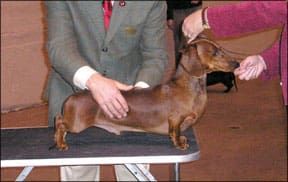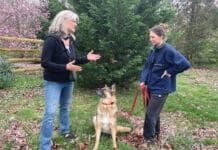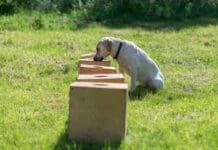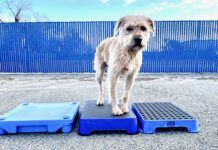TRAINING A SHOW DOG: OVERVIEW
1. If you have a mixed breed dog, Check out the Mixed Breed Dog Clubs of America, which offers conformation, obedience, and rally competition for mixed breeds.
2. Keep all your training sessions short and positive with your show dog.
3. Use a high rate of reinforcement when teaching a new behavior. Gradually reinforce your dog less with food and more with praise as he masters the tasks you are teaching him.
4. Check out author Vicki Ronchette’s book, Positive Training for Show Dogs, for more detail on training dogs for the show ring.
Sitting at ringside at a large dog show recently, I spotted a woman getting ready to go into the group ring with her Visla. After watching for a few minutes I commented to a friend that I thought the dog was clicker-trained. There was something very telling in the way the dog interacted with her handler that led me to believe that the dog felt comfortable trying things to impress her handler. After speaking to the handler, I found that the dog was clicker-trained, and had, in fact, been trained entirely with positive reinforcement methods. It is always very exciting for me to see people using these methods for the show ring.

You don’t have to be a judge to be able to recognize a show dog who loves what he is doing. A dog who really loves to show and enjoys what he is doing is obvious, even to the untrained eye.
Dog Show Basics
Almost everyone has been to a dog show or at least seen one on television, but not everyone knows how they work or why they exist. The original purpose of dog shows was for breeders to have their breeding stock judged. Many breeders will not breed a dog until the dog has completed its championship. The dogs who most closely match the breed standard in structure and temperament are the most desirable ones.
The largest registry for purebred dogs is the American Kennel Club (AKC). Most dog shows in the United States are AKC shows. There is also a United Kennel Club (UKC) and a Mixed Breed Club of America for people to compete in conformation with their spayed or neutered mixed breeds. I strongly recommend that anyone interested in doing dog sports with their mixed breed check out the Mixed Breed Dog Club. This organization allows mixed breeds to compete in conformation, obedience, and rally. It’s a lot of fun and a great way to get started in showing.
Successful Show Dogs: What it Takes
So, what does it take to be successful and win at dog shows? Besides having a dog who is a correct representative of his breed, you also need the dog to enjoy his “job.” Part of what makes a successful show dog is showmanship. A show dog needs to be able to perform and look like he enjoys it. The only way I know to preserve and enhance enjoyment of this work is through positive reinforcement techniques.
An important piece of the success puzzle is the relationship between the dog and the handler. In order for the dog to enjoy what he is doing and feel comfortable and relaxed in the ring, he needs to have a strong connection or relationship with the handler, whether the handler is his breeder, owner, or a professional handler. Positive reinforcement training can help strengthen that bond. Training methods that focus on positive reinforcement, rather than physical punishment, allow the dog to trust and feel safe with his handler; that, in turn, allows the dog to relax and enjoy strutting his stuff in the ring.
Clicker training and other positive training methods have made their way into many different areas of dog training, from teaching good manners to family pet dogs, to agility and rally competition training for professional canine athletes. The behaviors that are necessary for agility or obedience are much more complex than the behaviors required of a show dog. It only makes sense that positive training should find itself a place in show ring training as well. My goal is to make it the norm!

Positive reinforcement training can not only teach a dog the behaviors that he needs to perform in the ring, but also teach them in a way that the dog can have fun with and enjoy. Positive training allows the dog to try things and figure stuff out without having to worry about getting physically punished in any way. This, in and of itself, is incredibly powerful, particularly when part of the end goal is a dog who looks like he’s having fun.
There are three core behaviors that a show dog must learn to do well. He must be able to “gait,” “stack,” and be examined. Gaiting means moving at the proper speed and in the proper position without pulling on the lead, so that the judge can evaluate how the dog moves.
Stacking means he must be able to stand still on the ground (if he is a small dog, he must also learn to stand still on a table), so the judge can observe the dog and form an opinion as to how the dog appears when standing still.
Finally, a show dog must be able to stand still and remain calm while a judge examines him. The judge must actually put his or her hands on the dog to determine the overall structure of the dog. These are not particularly challenging things to teach. In fact, I have found that they are quite simple when using the clicker and other positive reinforcement techniques.
Equipment
To best show your dog’s conformation in the ring, you’ll need a special collar and leash combination.
For small dogs I like to use a Resco, “all in one” style collar with lead. The Resco is basically a loop with a slider that slides down to keep it snug where you want it on the dog’s neck. For medium or large dogs, I recommend a martingale style collar that closes up enough to keep the dog’s head from slipping out, but doesn’t continue to tighten like a choke collar would. There are “all in one” leash and collar martingales, or separate martingale collars that you can attach to a matching leash.
Clicker Training
I use clicker training a lot when working with show dogs. I see clicker training as sending non-emotional information to the dog. If your timing is good and your training plan is well thought-out, the clicker allows you to clearly communicate to the dog what, exactly, you want him to do.

How does this happen? The clicker tells the dog that whatever it was that he was doing when he heard the click was the behavior you want, and that a reward is coming.
In order for a dog to understand this, you have to set up a few training sessions for teaching the dog the relevance of the clicker. You do this by simply clicking and then giving the dog a treat. Practice this about 10 times in each session, then take a break. Make sure that you and the dog are not always in the same position or in the same location. You want him to learn that a click results in a treat, no matter what. Once you have done this, you can begin training some behaviors.
Keep your training sessions fairly short. Three minutes is enough time for a good session. Several short sessions throughout the day is plenty to teach the show ring behaviors. It’s fine to teach multiple new behaviors to a dog at the same phase of his training. However, it will help the dog if you work on each new behavior during its own, separate training session. For example, work on gaiting, and then take a break before moving on to stacking.
First Behavior: Gaiting
Gaiting a show dog seems like a simple behavior, but if you think about it, it’s pretty complex. You aren’t just “walking the dog.” Rather, you are asking the dog to walk at a certain speed, in a specific space in relation to your body. You don’t want the dog to pull on the leash, but you also don’t want him lagging behind. You need his tail and his head to be carried in the correct position for his breed. You don’t want him to sniff the ground or watch you as he moves. Oh, and he needs to look like he loves doing it! That’s a lot to ask for! You must train in baby steps to get there.
I typically start with the dog off-leash. I put some treats in my left hand and the clicker in my right hand. I let the dog know I have treats, and then I walk off. I click if the dog comes with me or if he even starts to come with me. After I click, I give him a treat at my left side, always with the dog’s head facing forward. I do not want the reinforcer to be delivered with the dog’s head facing me. Unlike heeling, where you may want the dog looking at the handler, in conformation we always want the dog’s head facing forward, so that the judge will always see the dog moving in profile.
Once the dog seems to understand what I’m rewarding him for, and is reliably moving alongside me, I will add the leash. At this point, I put the treats in my right hand and the clicker and leash in my left hand. Be sure to gather up the leash so it isn’t hanging down in a distracting manner.
Once again, start walking and click and treat immediately if the dog walks off with you – always delivering the treat with the dog’s head facing forward. If your dog pulls ahead, simply say “Uh-oh!” or “Oops!” in an upbeat voice, and go back to where you started. On the next attempt, try to click and treat very soon – before the dog has a chance to pull. Click and treat frequently, as long as he’s by your side. Do not yank or jerk on your dog’s neck; this will not help him understand what you want and it won’t teach him to like the conformation game.
Once your dog learns to move alongside you without pulling, you can begin to slowly “raise your criteria” – that is, require that he do a bit more before you deliver the click and treat. Adding changes is challenging, so only add one at a time. For instance, if your dog is watching you and pulling while you move, you might need to ignore the fact that he’s looking at you while you teach him not to pull. Once he isn’t pulling, you can begin to click only when his head is forward. Ask for small pieces at a time. This is really important because if you ask for too much, your dog won’t be able to figure it out and both of you will get frustrated.
Once the dog is moving correctly, in the right position and at the right speed, begin to click less often (lower the “rate of reinforcement”), until you are using mostly your voice as reinforcement, with infrequent treats. At this point, I put this on cue or command by telling my dogs, “Let’s go!” just as we take off.
Stacking
Stacking is the behavior in which the dog stands in the proper position for the written standard for his breed. There are two kinds of stacking: free stacking and hand stacking. Free stacking is when the dog finds the position on his own; while you may prompt him to reposition a foot or two, you don’t put your hands on the dog. Hand stacking is where you actually manipulate the dog into the position that you want.

photo by susan joseph
The dog will have to be stacked a few times in each visit to the show ring: immediately upon entering the ring; before being moved as a group; individually for hands-on examination by the judge; and at the end, for the lineup with the other dogs.
Small dogs will be examined by the judge on a table, so they must learn to stack both on the ground and on a grooming table. Medium and large dogs will be stacked on the ground. Some shorter but heavy breeds such as Basset Hounds and Bulldogs may be examined on ramp, or a lower larger table that they walk onto. Many people will hand stack the dog only for the judge’s examination and let the dog free stack the other times.
Hand Stacking
Don’t use a clicker for the hand stacking; it’s too easy to click right by the dog’s ear, which won’t be pleasant for the dog. Also, you will need both hands to hold the bait (treats) and reposition the dog. Small dogs will be hand stacked on the table and medium and large dogs will be hand stacked on the ground.
Start out with a good chunk of bait. With hand stacking, use bait the dog can nibble on, such as a slice of dog food roll (tubed food) or a chunk of chicken breast. Position the dog so he is standing sideways in front of you; you face his right side. With the food held securely and somewhat protected in your right hand, allow the dog to nibble and chew off little pieces as you position his body with your left hand.
Whether you place a small dog on the table or walk a large dog into a stack, always start with the dog’s front feet in the proper position; that way you have to reposition only the rear feet. When positioning the front legs, move the legs at the elbows. When repositioning the rear legs, move the legs at the hock. Never, ever reposition the dog’s legs by grabbing at his feet; this almost always makes him shift and reposition himself in a way that you don’t want. When hand stacking, always gently smooth your hands over the dog, keeping your hand on him, rather than pulling your hand off and back on his body, which can startle him and make him shift. Once he is in position, give him one last nibble, and then give him a break before you start over. Practice this until he is comfortable being hand stacked.
The next step will be to teach him to hold it. Stack him, then say “stay,” and pull the food away from his mouth for just a moment. If he holds his position, say “Yes!” and give him a bite of bait. Repeat this, slowly increasing the amount of time that you require him to stay put, as he becomes comfortable holding the position.
Some dogs will get too stimulated with a chunk of food and do better without the food being held at their mouths. For a dog like that, put the treats on a table nearby. Walk him in front of you (or put him on the table if it’s a small dog), then put your right hand into his collar, and gently talk to him as you reposition his front legs; then reach for a treat, give it to him, and then let him take a break.
Once he is comfortable with that, do the same thing, but then fix his rear feet as well. Gradually shape this behavior so you can stack him, have him hold the position, and then go and get a treat.
Free Stacking
Just like everything else, train this behavior in baby steps. Begin by getting some treats and your clicker. Initially, click if your dog stands, whether or not he stands perfectly. If he continues to stand, click and treat again and again. Move away and allow him to walk up to you, and click and treat him before he has an opportunity to do anything else. Continue to do this until your dog offers the stand position. Do this until your dog easily stands very frequently.

Next teach your dog how to stack himself in the position that you want. I like to teach the dog to “back up” (which means “step backward and reposition your rear feet”) and to “step” (which means “step forward so that both front feet are side by side”).
To teach “back up,” step slightly toward your dog and click and treat any shift of movement backward. Do not expect a full “back up” initially; shape it by clicking and reward increasingly correct, successive approximations of the backing up behavior. Another way to teach “back up” is to have the dog walk toward you in between two objects, such as the long narrow space between your couch and coffee table, and click and treat when he backs out. Once the dog is easily able to step back, say “back up” right as he backs, then click and treat.
To teach “step,” I simply prompt the dog by stepping back slightly and clicking and treating as soon as he moves a front foot forward. Once he can do this easily, say “step” just before you prompt him.
In the end, free stacking will look like a dance with you and the dog. If he doesn’t stack perfectly, you say “back up” and reinforce that, or “step” and then reinforce that. When he finally ends up just how you like it, say “stack” and then click and treat him! If he holds it, click and treat him again. Reinforce him richly when he finds the proper positioning.
Some people feel that show dogs shouldn’t be taught to sit because the dog will sit in the ring. This typically happens because the owners practice more sits than stands. If you reinforce standing a lot and make it very rewarding, there is no problem with teaching both sit and stand.
Judge’s Examination
Most social, well-adjusted dogs don’t mind the gentle handling meted out by a judge. However, you just have to make sure that your dog is comfortable with people putting their hands on him. Get him used to this as early as possible. Make it a part of your daily routine to put your hands all over your dog. Get him used to you examining his teeth. If you have a male dog, get him used to having his testicles touched. If you have a small breed that a judge may lift up (such as a Pekingese), get him used to this.
I like to let my dogs know what’s coming next by saying a word right before that part of the examination. Every time I examine my show dog’s bite, I say “mouth please!” so he knows it’s coming. I do this in the ring as well, to let him know that someone is about to look into his mouth. Once your dog is comfortable with you doing these things, practice by having friends do the same thing. Remember to let your friends know to be gentle and respectful when examining your dog.
Good handlers make showing a dog look easy. The truth is, the behaviors are not overly complex, but it will make your job – and your dog’s job – so much easier and more enjoyable if you really put the time into training them well. Using positive reinforcement techniques will not only help the dog enjoy the training process but also teach him to like the ring behaviors in general.
Vicki Ronchette, CPDT, CAP2, is a dog trainer and behavior consultant specializing in positive reinforcement training for show dogs. She is the author of Positive Training for Show Dogs: Building a Relationship for Success, and owns and operates Braveheart Dog Training, in San Leandro, California.







I have a 17 no old Cavalier male show dog who doesn’t like being touched by the judge. In spite of class training and having people touch and feed him he doesn’t like the judge. He tried to nip athe judge yesterday and got kicked out of the ring and banned from all AKC events. I am devastated. Is there any hope for him?
Were you excused from the ring or was a bench committee called on you and your dog? For a puppy to be excused for “unable to examine” is not much of a big deal. However, if your dog actually made contact, bit and broke skin is a completely different deal.
More details are needed in order to give correct advice.